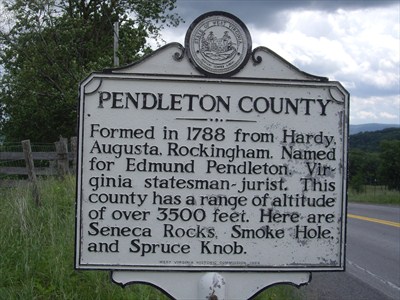|
Moderated by NW Okie! |
Volume 14 , Issue 382012Weekly eZine: (374 subscribers)Subscribe | Unsubscribe Using Desktop... |
Pendleton County, (West) Virginia

Through Oren Frederick Morton's book, History of Pendleton County West Virginia, we learn that no state suffered more severely from the effects of the four years war (civil war) than the Old dominion. There was general devastation all over.
The returning soldiers came back to farms that bore deep traces of long neglect, and to homes that had been plundered from garret to cellar. Numbers of domestic animals had become small, and it was o easy matter to find enough wearing apparel to serve for everyday needs.There was little money in circulation and little to sell. The only money of purchasing power was the slender amount of specie that had come through the war and the paper currency of the victorious North.
You need to add to these results and to the disorganization of civil authority, the fortune of war had detached the county from Virginia, and had included it with no expression of its own opinion in the new state of West Virginia.
The county of Pendleton had an advantage per most Southern communities,though. There had been very few slaves. The people were accustomed to helping themselves. In the labor situation there was consequently no material change. The ex-soldiers went manfully to work to repair the damages of war and to get back as soon as possible to something like their material condition at the oust of the struggle. You can find their success in the books of the assessor for 1860 and 1868.
By becoming a part of West Virginia, Pendleton was spared the direct experience of going through the reconstruction undergone by the seceding states, and the six years that was a transition period of somewhat similar tendency so far as the ex-Confederate minority was concerned.
War was/is always accompanied by a weakening of the restraints of morality, integrity and social order.
The ill feeling between the two factions of the Pendleton people during the great war had made the county a scene of disorder and violence. It was happily not followed by any murders after the return of peace, yet the resentments called into being could not at once utterly subside. The effects of the four years of civil turmoil were apparent in an increase in the number of instances of assault and illegitimacy.
Pendleton was one of the three counties of the state which did not limit themselves to a board of three commissioners. Since 1 January 1903, there had been a commissioner from each district, this giving to purely local interests a better recognition.
It was in 1873 the air began to be filled with rumors of approaching railroads, none of which had yet been definitely realized. In October of 1873 there was a proposal to vote to the Shenandoah Valley and Ohio Railroad, the bonds to be in amounts of $0 and upward, to run 24 years, and not to be sold for less than their par value.
The conditions were imposed that the road must be under actual contract from Franklin to the terminus in the Shenandoah Valley, and that no part of the subscription should be spent outside of the county. D. G. McClung, J. E. Pennybacker and J. D. Johnson were appointed agents for the subscription, but the financial panic of the same year gave the projected road an effectual quietus.
The next railroad project to take serious form was the Chesapeake and Western. April 20, 1895, a vote was ordered as to whether the county would issue the bonds of Pendleton county to the amount of $32,000, to be subscribed to the capital stock of any responsible and reliable company that builds a railroad through this county along the South Branch valley from and connecting with some general line of railroad passing or to the county seat., and also secure to such company the right of way for such railroad through the county.
Franklin and Mill Run districts were each to pay half of the issue, and each of the other districts -- the bonds had a maximum and minimum life of 2 and 15 years. Still another election was ordered for December 7, 1873, the projected road to run by way of the South Fork, Franklin, Smith Creek, and Circleville.
Another paper railroad appeared four years later. A vote was ordered for September 16, 1877 on a levy to pay for the right of way of the Seaboard and Great Western from Skidmore's Fork in Rockingham to the line of Grant county. This order in turn was rescinded, and a vote ordered 14 days later,enabling the districts of Sugar Grove, Franklin, MillRun and bethel to vote a subscription to pay the damages on a width of 100 feet in the right of way. Still another project was the "C. & I." railroad in 1902, in behalf of which an election was called for the third of May.
Pendleton county had thus far escaped the unenviable fate of having to pay bonds on a fraudulent project. But the only appearance of railroad construction within its borders was found in about 50 yards of grading a mile south of Franklin. The embankment was in good order, and nothing stood in the way of its being a portion of a trade route except a certain number of miles of grade above and below, with ties, rails, rolling stock and various other accessories and conditions.
| View or Add Comments (0 Comments)
| Receive
updates ( subscribers) |
Unsubscribe
| © . Linda Mcgill Wagner - began © 1999 Contact Me | |
